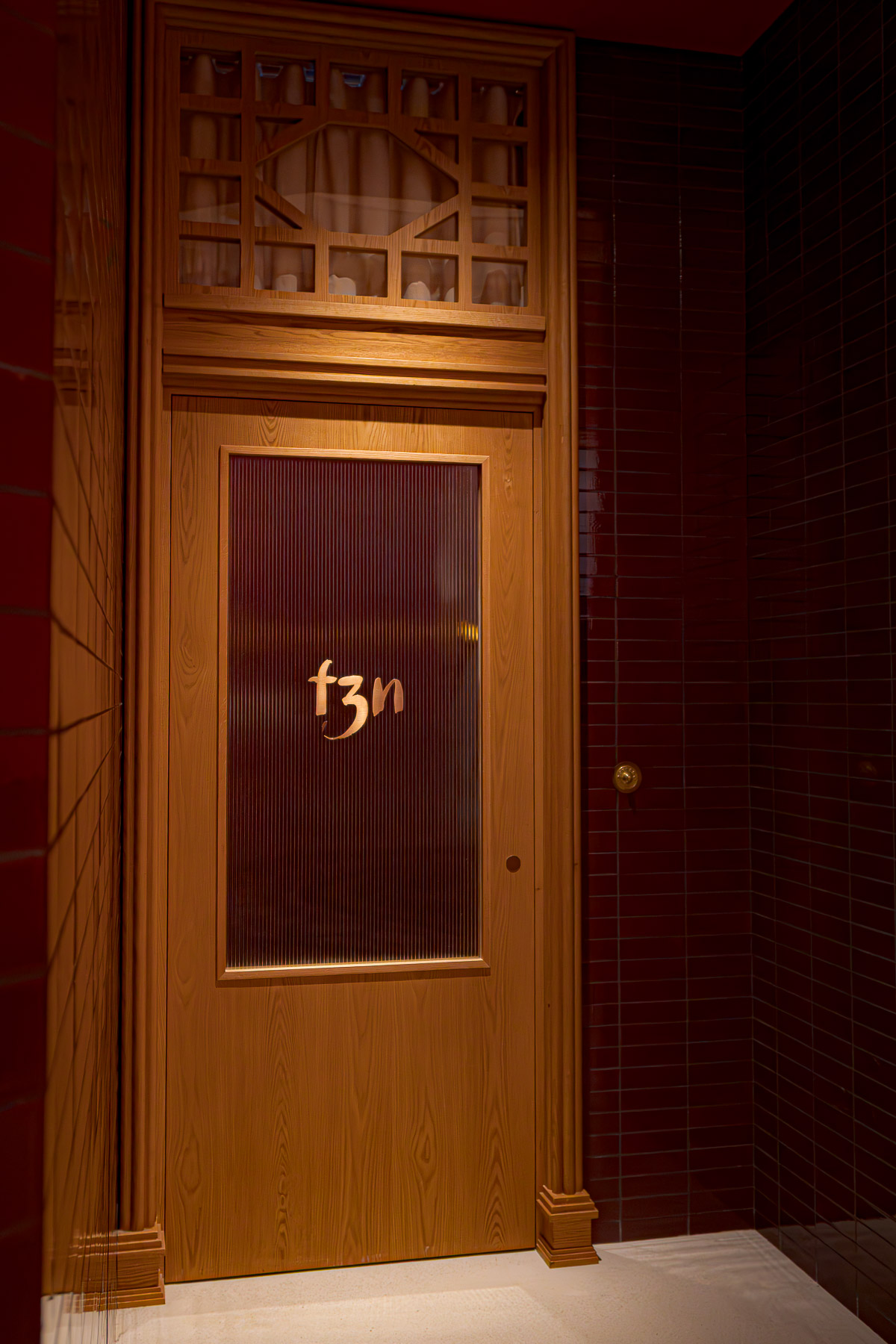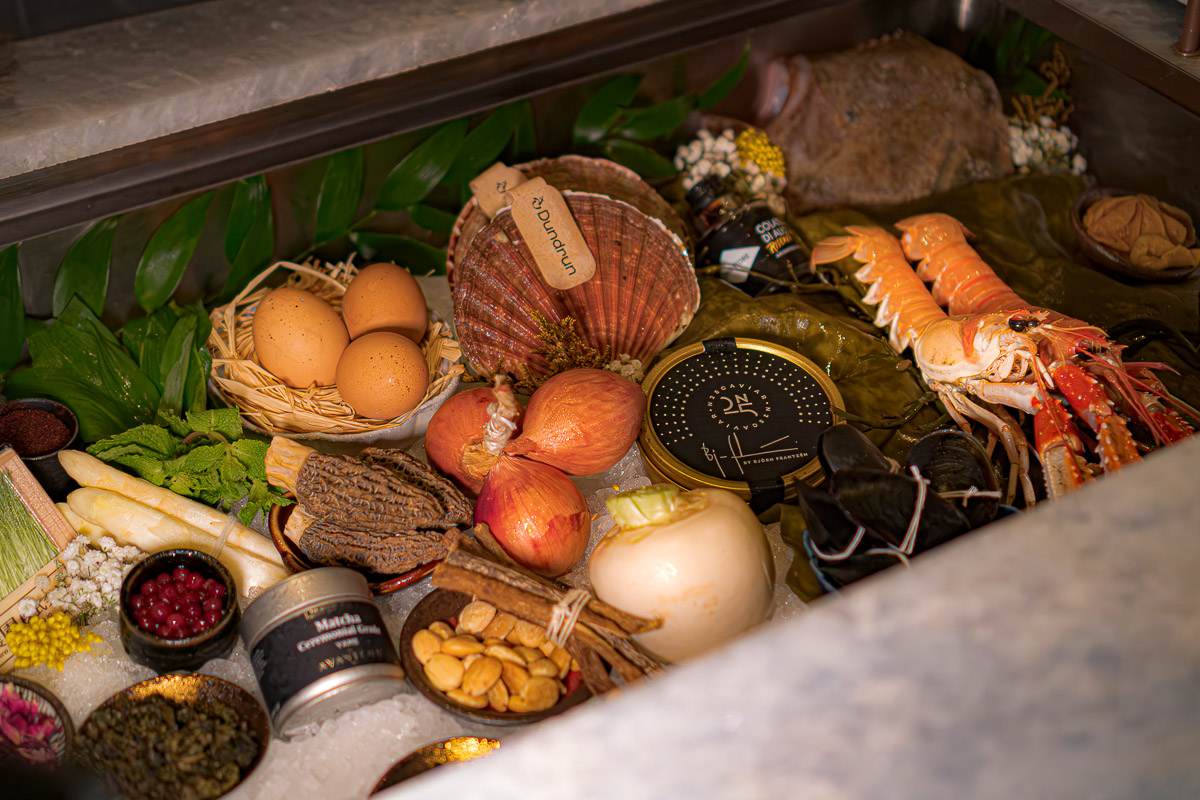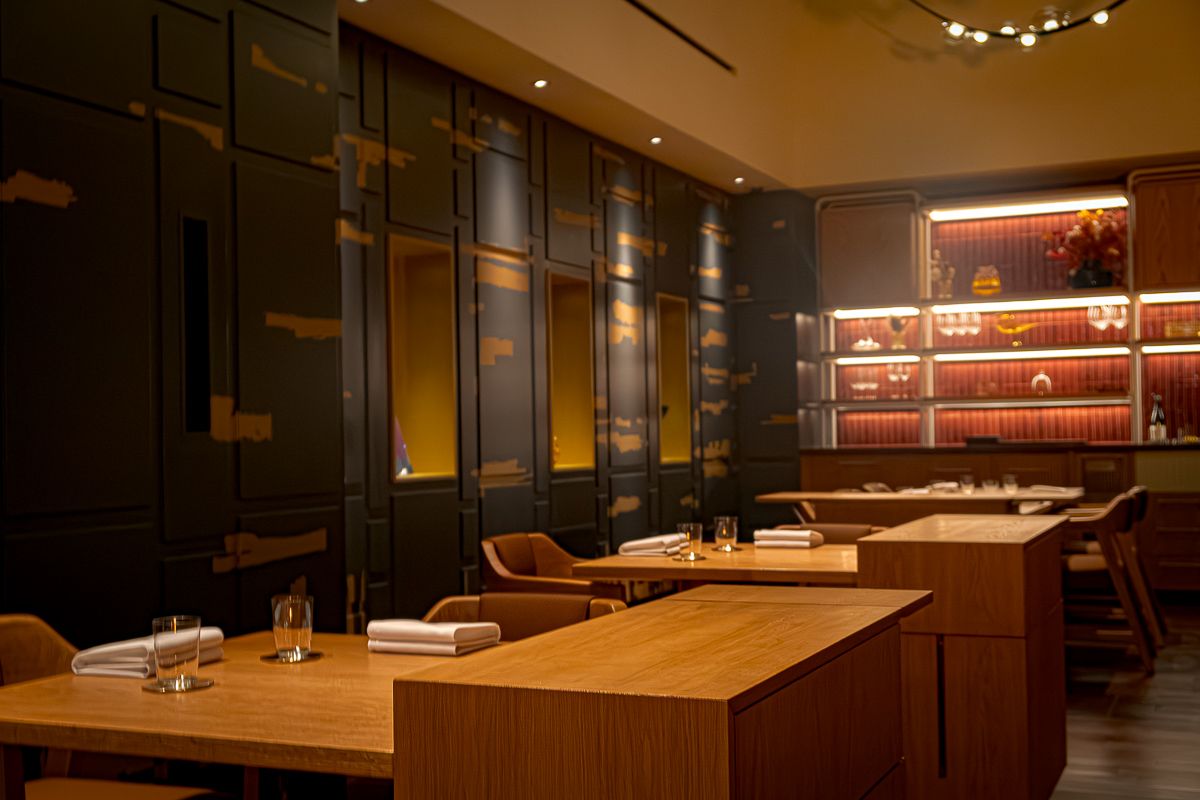The Closed Door
There’s a doorbell. Just a doorbell.
In Dubai – a city that advertises everything in gold leaf and fifteen-metre-high letters – Björn Frantzén hid his restaurant behind an unmarked door. You ring. You wait. The door opens, and the desert disappears.
FZN replicates the philosophy of the Stockholm original with watchmaker precision: the closed door, the succession of floors that turn dinner into a vertical journey, the showcase where ingredients rest like jewels – half desire, half expectation.
The cooks look as if they’ve stepped straight out of a Scandinavian fashion editorial: young, elegant, concentrated.
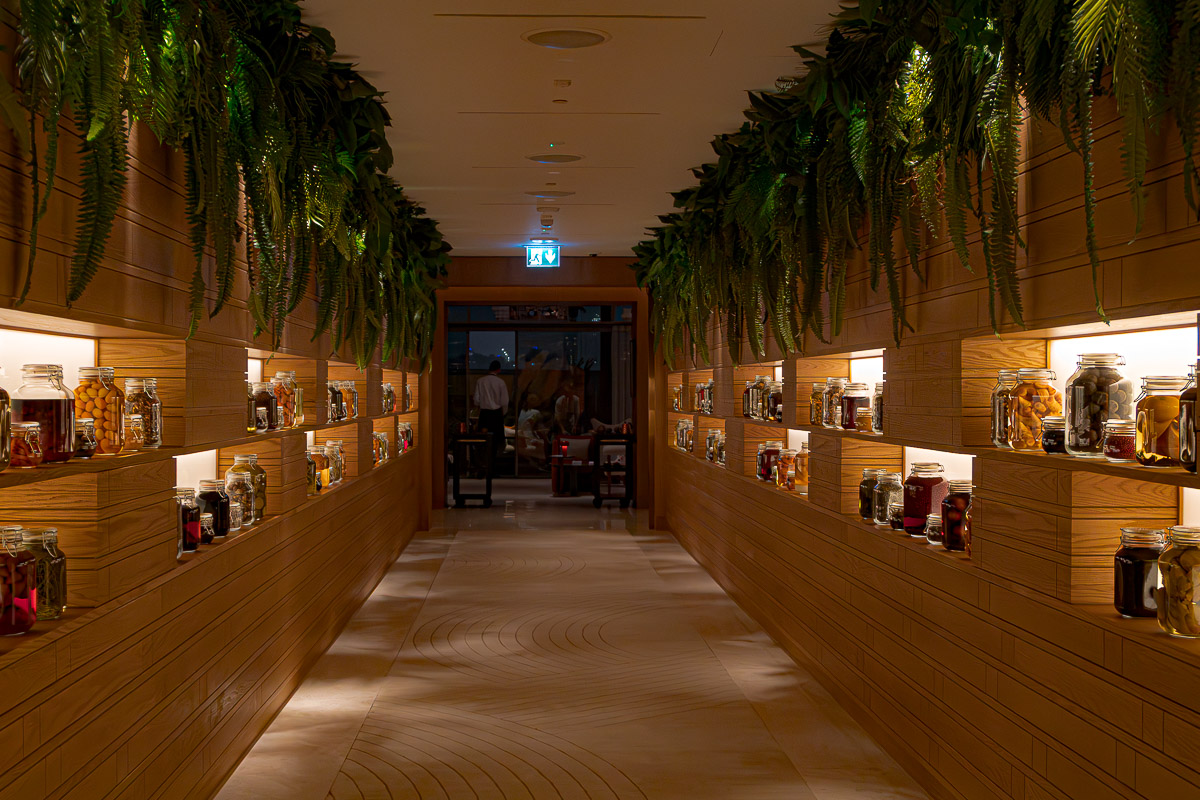 But the real transformation happens when you step out of the lift. Something changes.
But the real transformation happens when you step out of the lift. Something changes.
You cross the hallway and suddenly Dubai – the gold, the noise, the heat that bends the horizon – dissolves.
You are in another dimension, where humans are sharper, gentler, and every gesture quietly confirms you’ve made the right choice.
The pale wood breathes calm. The light is composed like music – its textures, pauses, and silences perfectly tuned. Everything is deliberate. Everything is calculated. And, strangely, none of it feels oppressive.
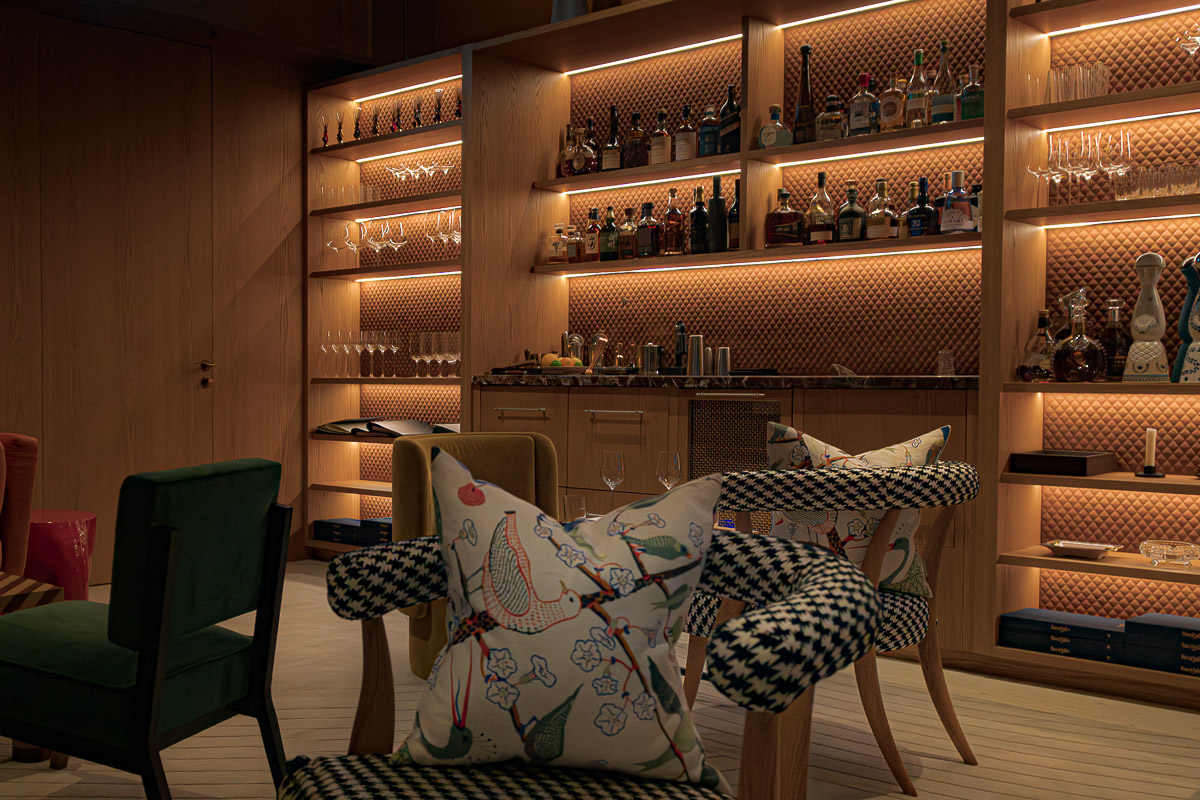 They welcome us with a glass of Chavost Brut Nature – bone-dry, almost austere, the kind of Champagne that makes you sit straighter.
They welcome us with a glass of Chavost Brut Nature – bone-dry, almost austere, the kind of Champagne that makes you sit straighter.
The team moves with choreographed subtlety, a daily theatre directed by Torsten Vildgaard and Karin Ågren, who ensure that nothing and no one rushes. It’s the sort of service that cannot be forced.
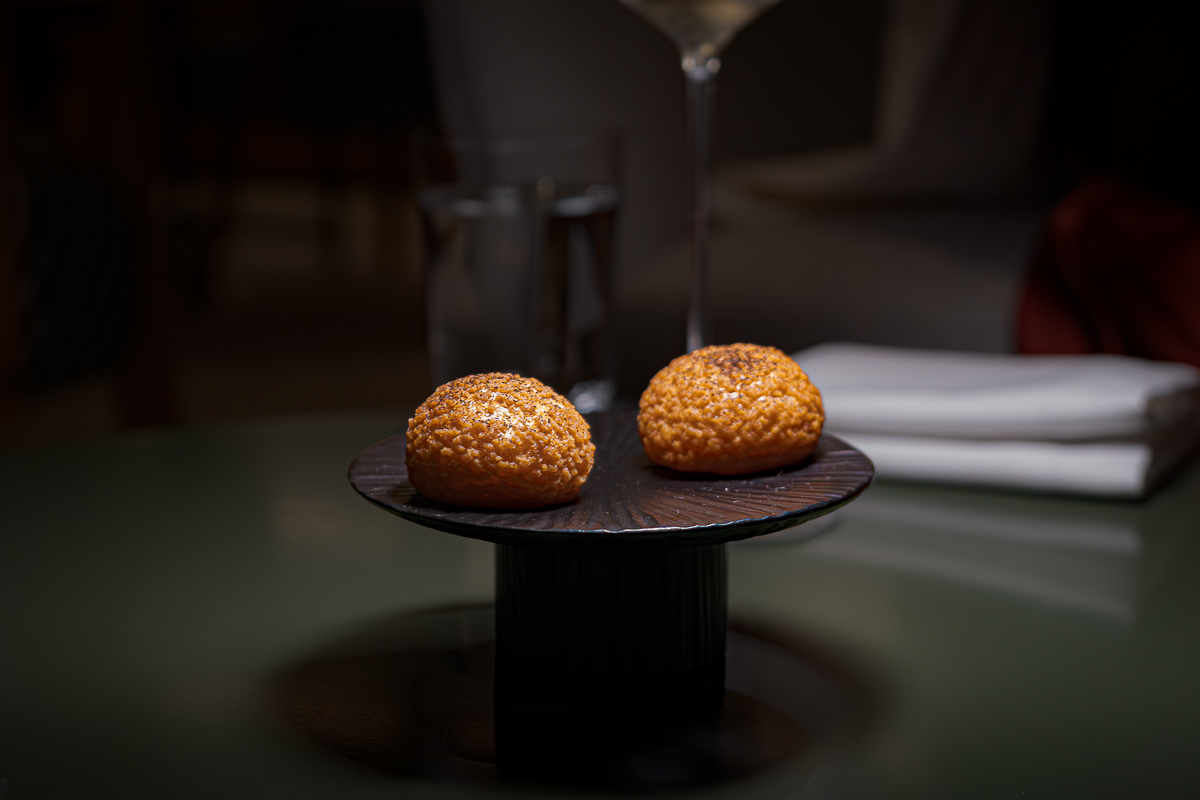
The Prologue
Dinner begins in the lounge, where the snacks aren’t mere appetisers -they’re warnings.
A hot, crisp choux de Bourgogne, filled with Mornay sauce and a lush blend of Comté, Brillat-Savarin, Langres, and Marc de Bourgogne.
Then, a brittle celery-root taco packed with langoustine tartare, finger-lime caviar, vanilla, orange, and fennel.
The acidity strikes first, then the crunch of the shell, and finally, the citrus pearls explode and dominate everything. Aggressive – in the best way.
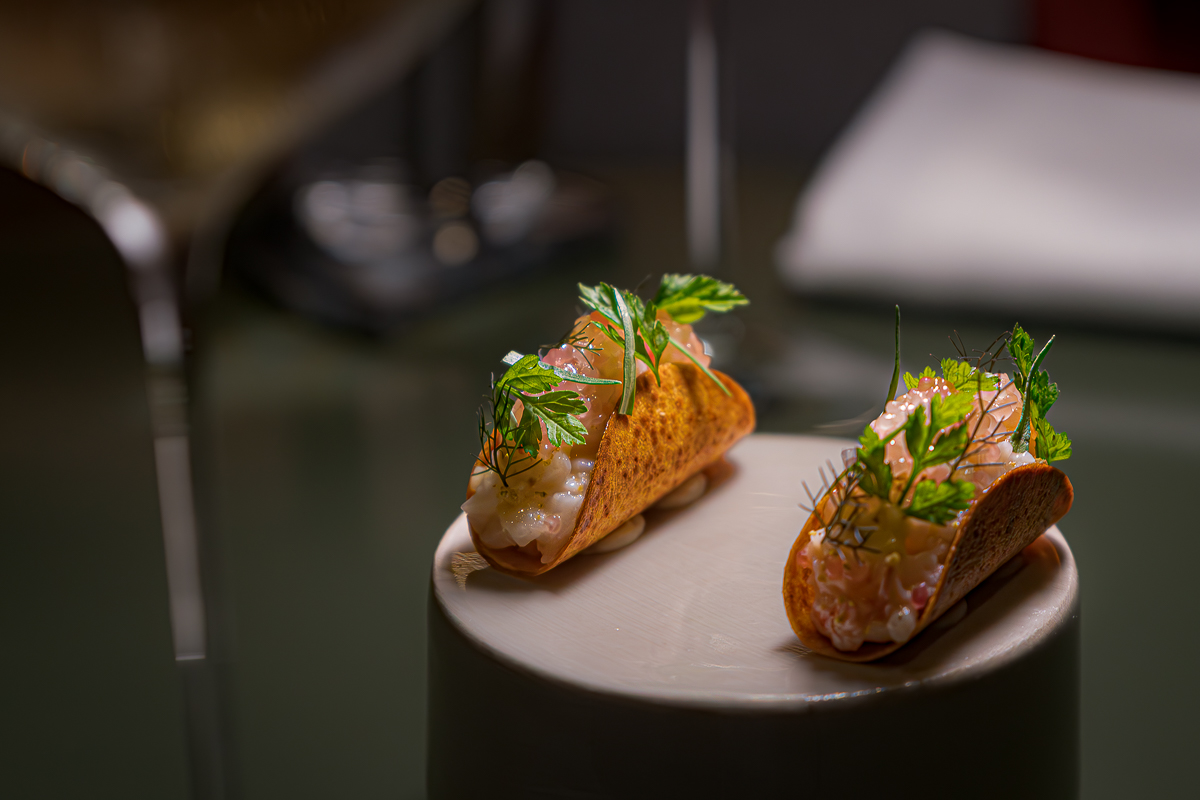
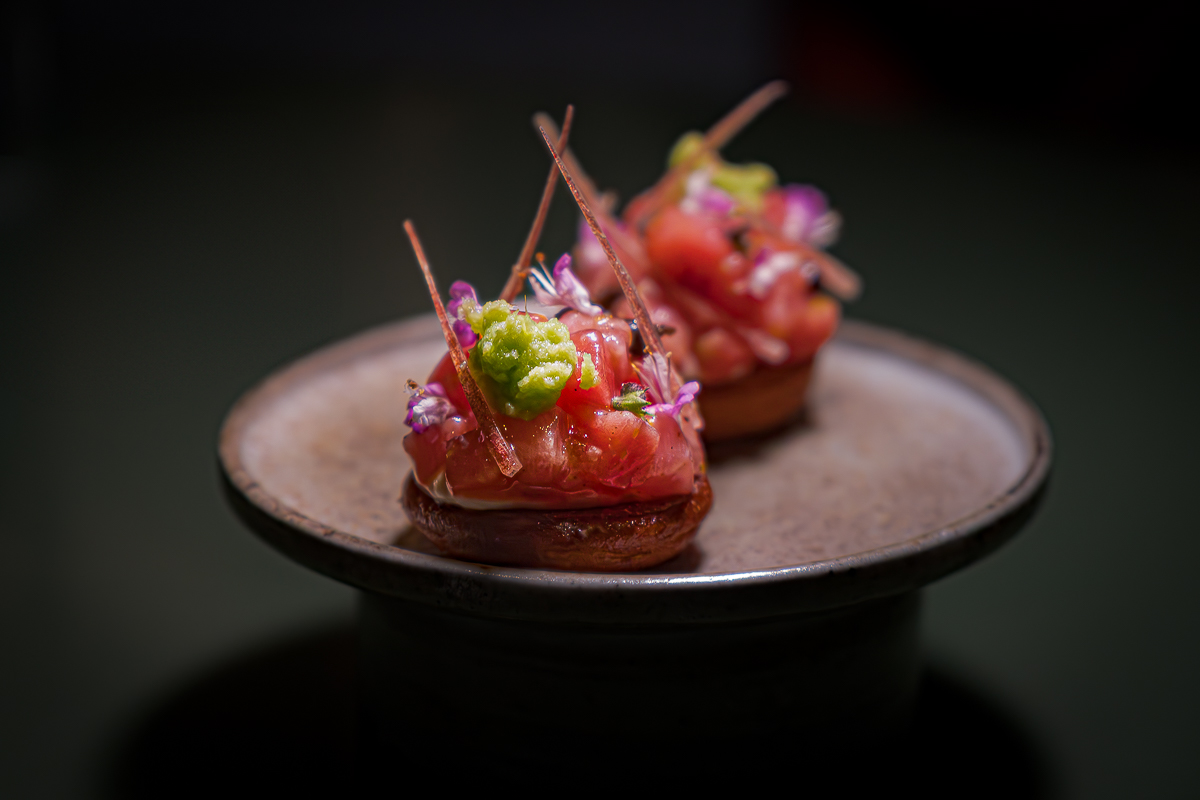
Next comes the Asian undercurrent so typical of Frantzén’s cooking: a buckwheat-blini crowned with otoro tartare, seasoned with ponzu, myoga flowers, wasabi, and Arima sansho pepper. The ingredients are Japanese, but the intensity of flavour is anything but. The tuna is boldly seasoned and finishes with that sansho tingle that doesn’t burn – it lingers.
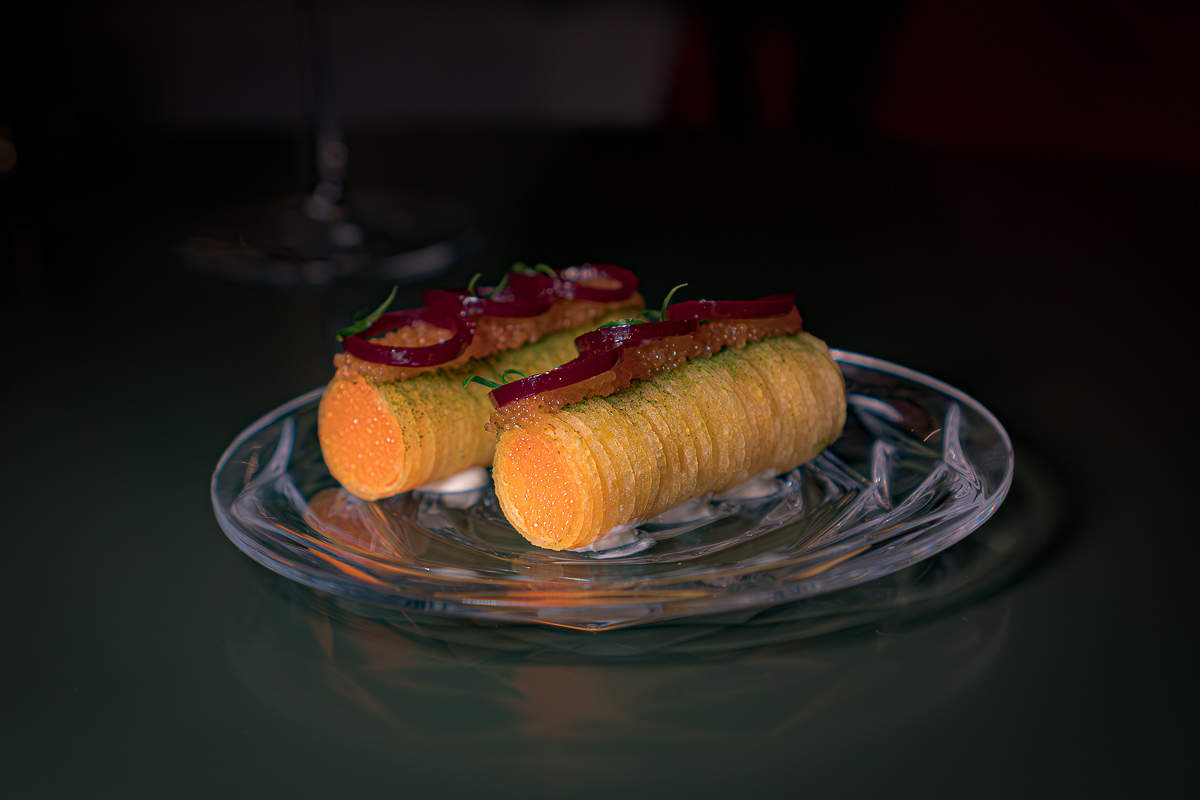
Then a classic: Frantzén’s interpretation of råraka, the Swedish potato dish. A crisp potato base, crème fraîche, lemon juice, shallots, pickled onion, chives, and whitefish roe. Crispy, creamy, and with the acidity of the pickled onion balancing everything.
The Champagne cuts through the fat like a cold wind through fog, leaving just the right edge of acidity to move forward.
Before the transition, they present the night’s ingredients – the ritual we’ve all seen online.
The final snack arrives: a yuba tartlet (the skin of soy milk) filled with ricotta, green asparagus, and vadouvan spices. Another perfect snap, another perfect equilibrium.
The precision borders on obsession.
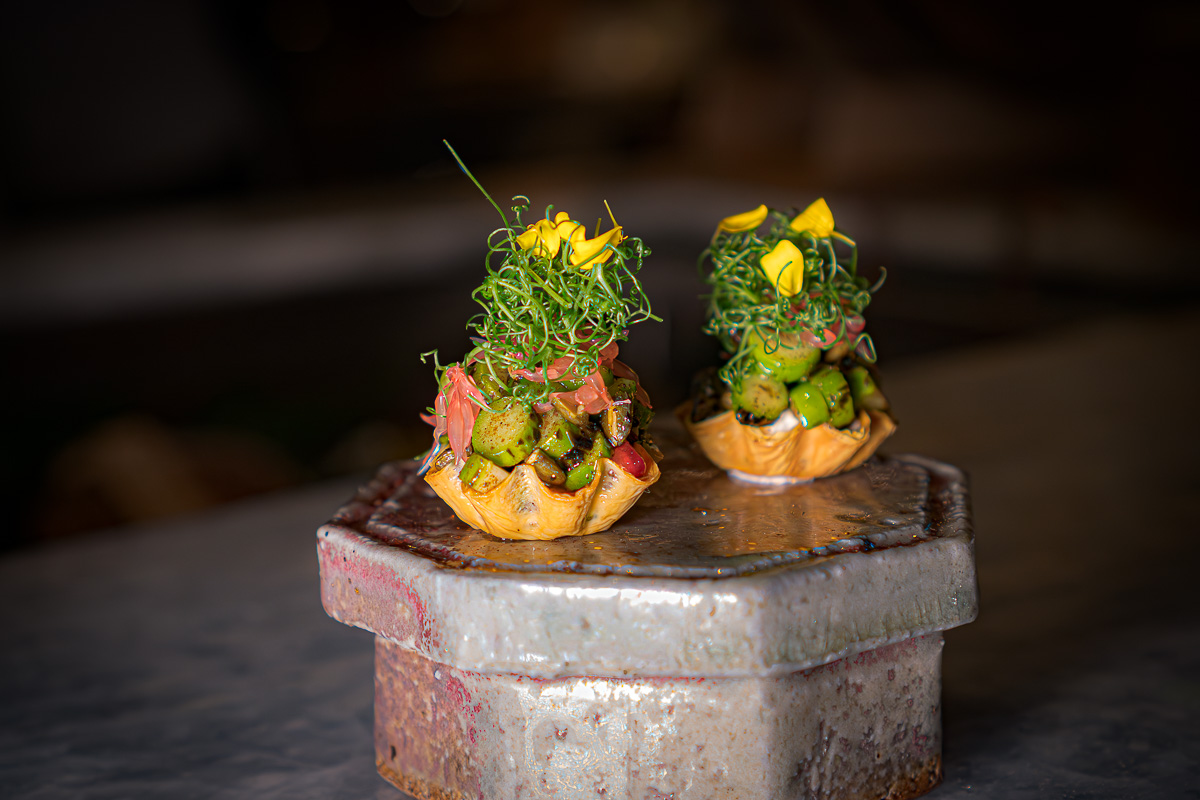
By now, we were questioning the rumours – could they really be heading straight for a third star?
The Theatre of the Real
We descend a floor, cross the wine cellar, and enter the prep kitchen.
A chef opens a live scallop in front of us, explains its anatomy, and slices out the adductor muscle – the part that will be eaten. It still twitches.
It’s the moment you realise there’s no illusion here – only product, attention and time.
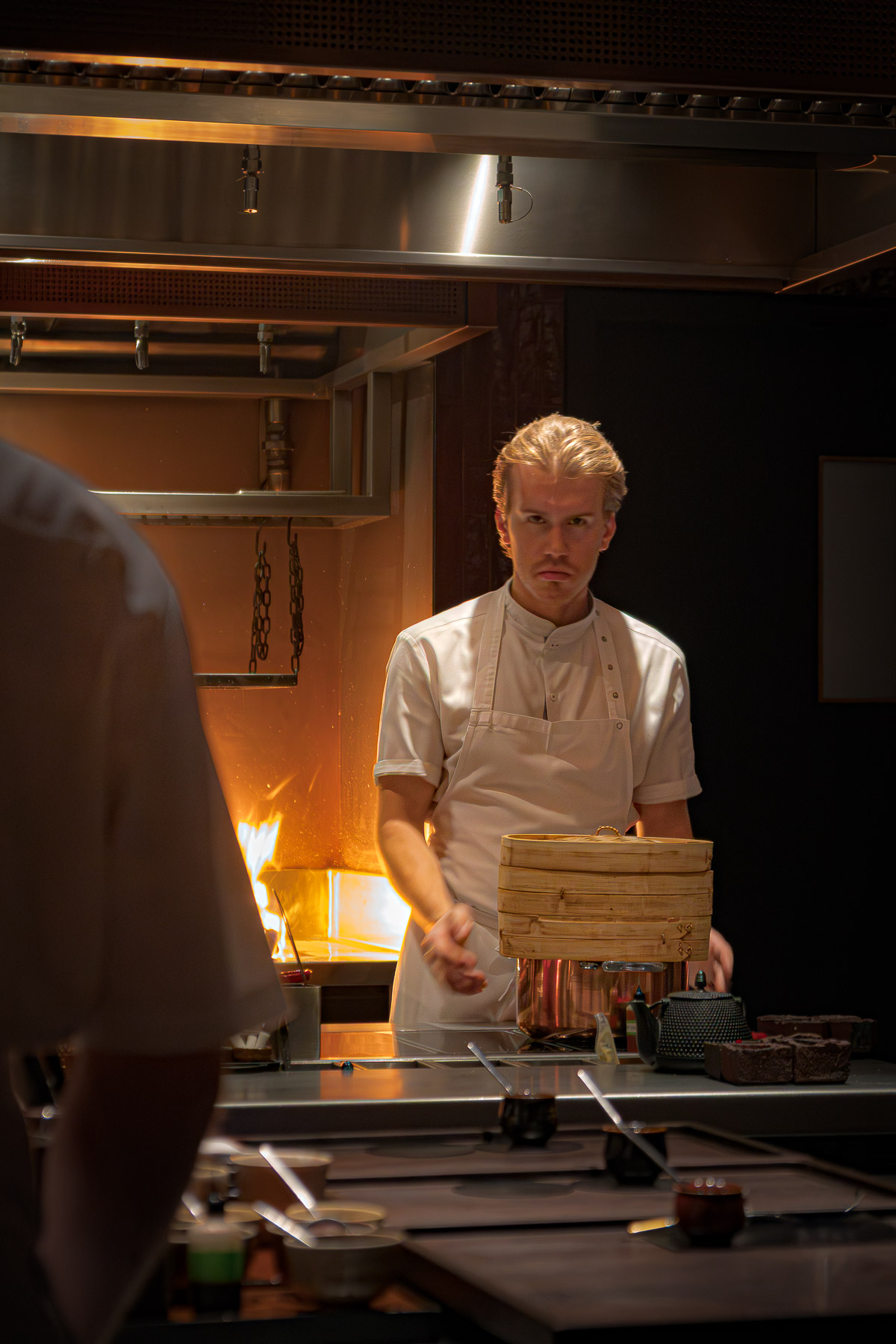 Minutes later, seated at the main counter, that same scallop returns – translucent, sweet, served raw, seasoned with fermented apricot and colatura, topped with thin layers of turnip.
Minutes later, seated at the main counter, that same scallop returns – translucent, sweet, served raw, seasoned with fermented apricot and colatura, topped with thin layers of turnip.
Its texture is silk; its flavour, a quiet marriage of butter and fruit sweetness, brushed with a gentle umami that seasons without overpowering.
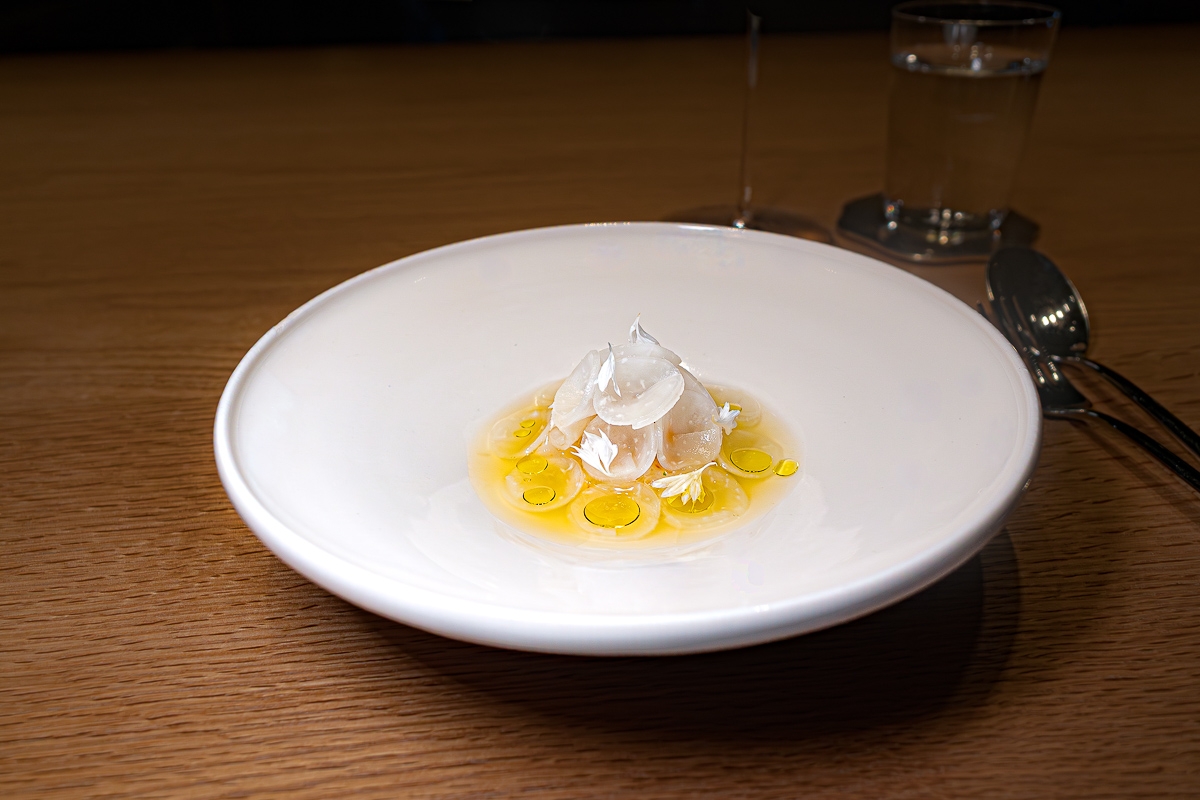
It’s beautiful, technically flawless, delicious.
But it lacks the power of the opening snacks – as if someone had turned the volume down after a thunderous overture.
A pause in intensity, a measured breath before the next act.
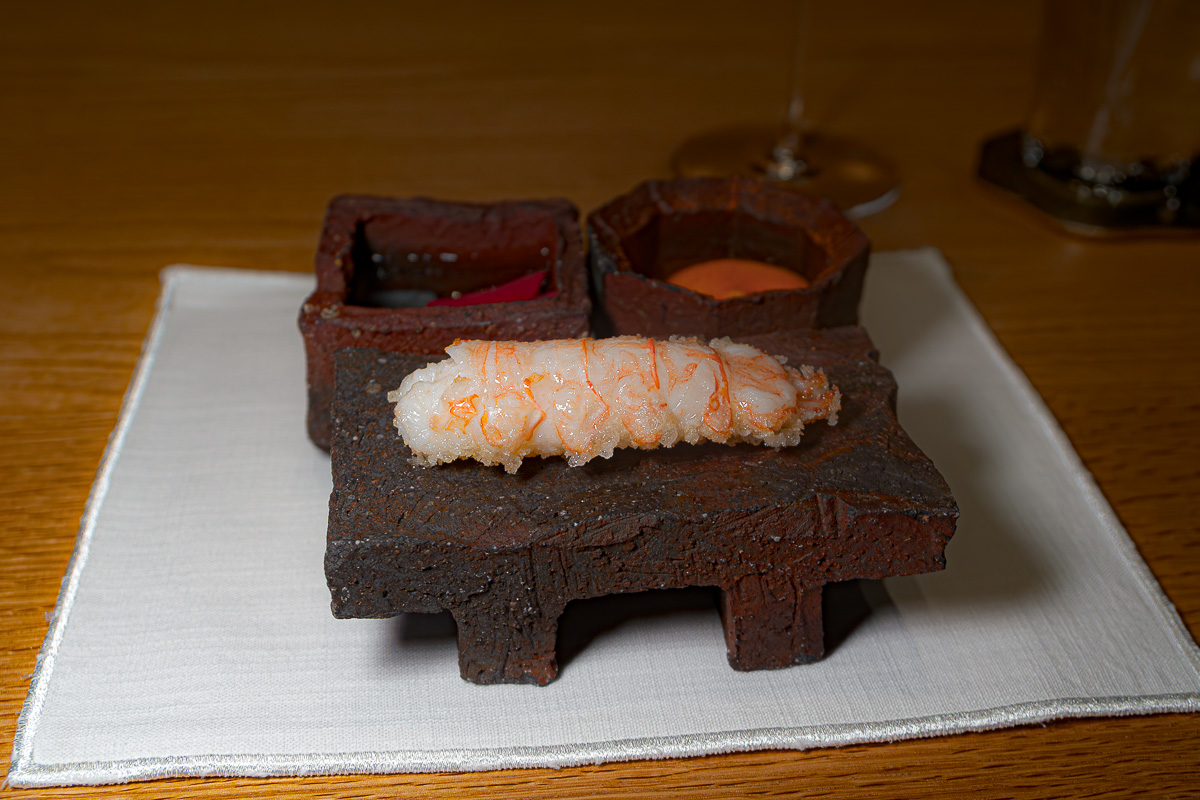
The Crispy Langoustine
A langoustine tail, the underside coated in puffed koshihikari rice. Beside it, a bowl with two sauces: a yuzu butter emulsion and a choron – a tomato béarnaise.
Another small bowl holds only water to rinse your fingers. (Why did seafood restaurants ever abandon this ritual?)
The room stills as it arrives.
The langoustine is hot, freshly fried.
The rice gives it a delicate crunch; the sauces evoke memories – tomato, butter, something that whispers of shellfish and spicy ketchup, yet refined, elevated, irresistible.
The cocktail sauce above all cocktail sauces.
This is Frantzén’s signature dish: simple in concept, impossible in execution.
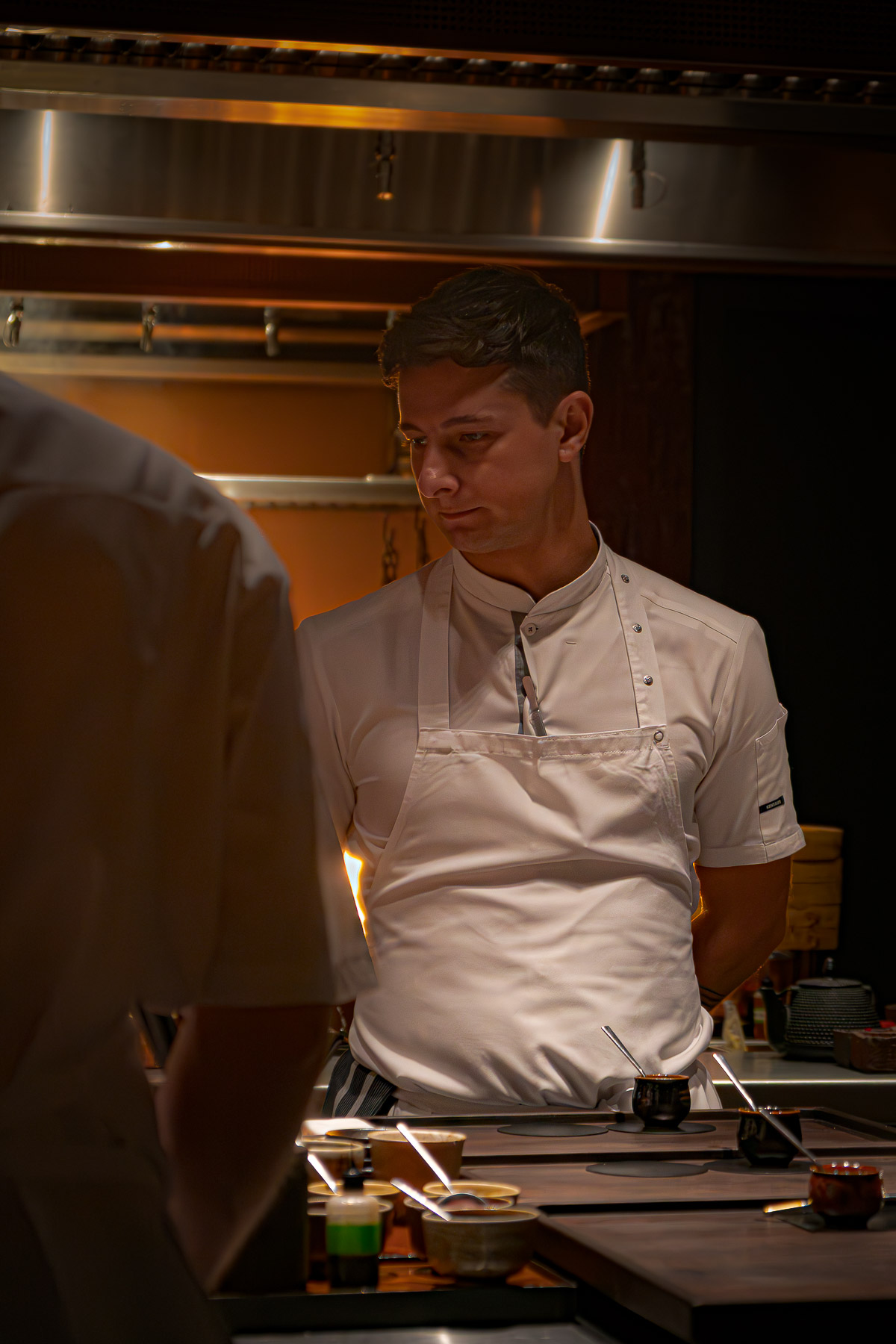 The Riesling Kabinett “Oberhäuser Leistenberg” Dönnhoff 2022 plays its part with elegance – residual sugar to embrace the shellfish’s natural sweetness, acidity to cut through the buttery sauce.
The Riesling Kabinett “Oberhäuser Leistenberg” Dönnhoff 2022 plays its part with elegance – residual sugar to embrace the shellfish’s natural sweetness, acidity to cut through the buttery sauce.
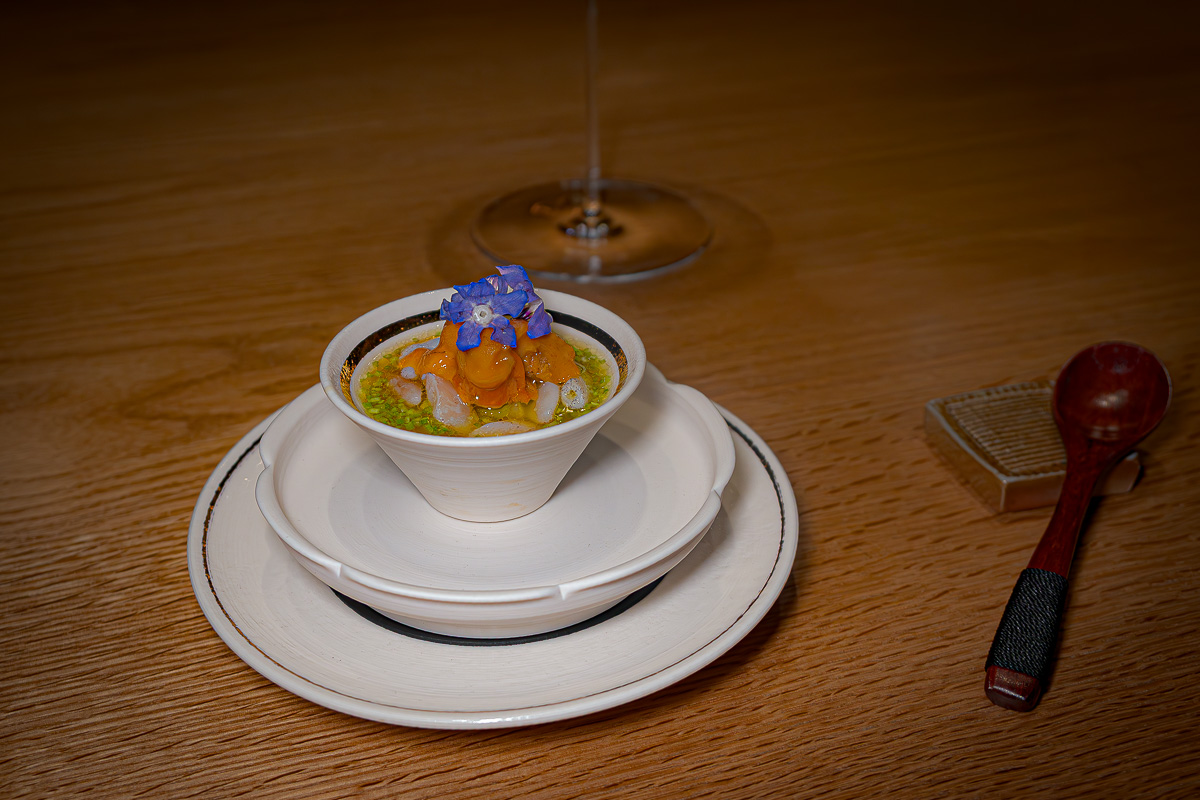
Smoke and Memory
Next comes the chawanmushi – smoked beef broth, grilled razor clams, and sea urchin.
The custard is pure silk; the smoke, a note that lingers in the air.
The razor clams add texture, and the sea urchin melts into everything as if it always belonged there.
It tastes of sea, of fire, of meat, of sweetness, and acidity.
Disorienting, in the best way, and that is precisely why it becomes addictive.
The sauce gives depth, fat, and strength of character.
It shouldn’t work – but it does, brilliantly.
I’d come back every day for this dish.
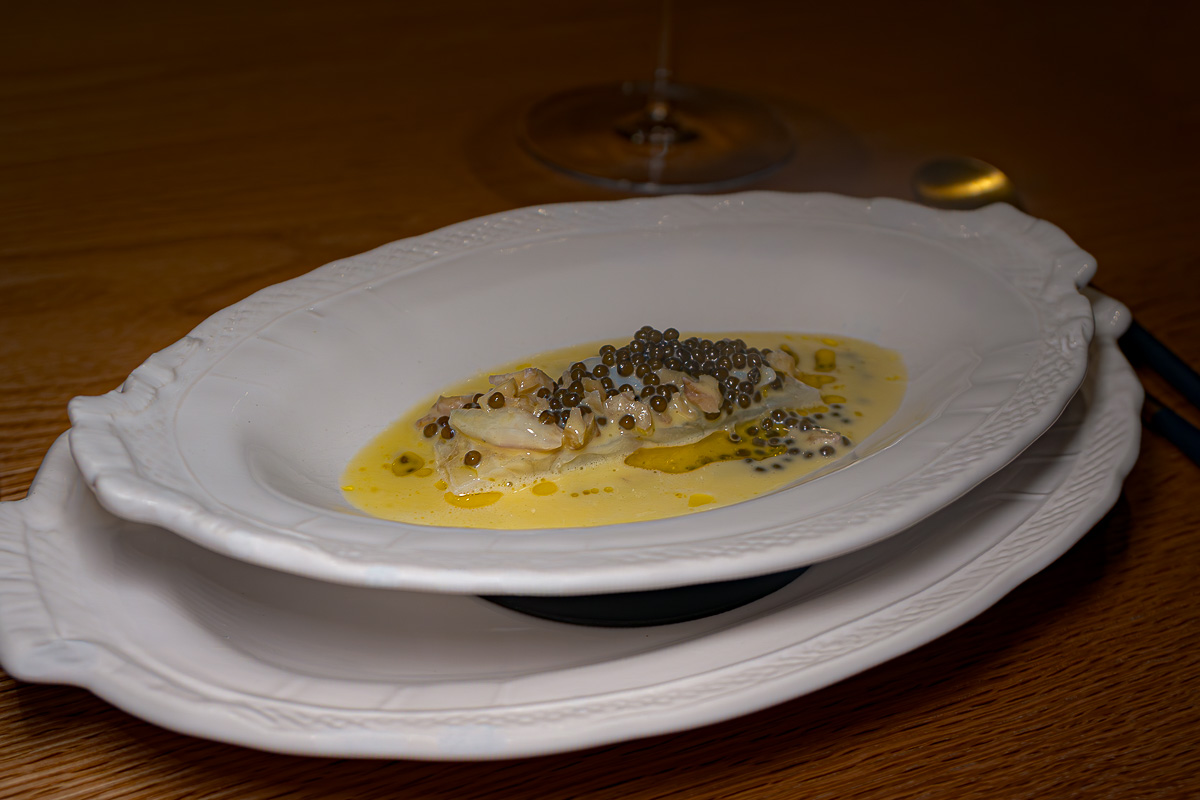
The Turbot with Tahini
Then the mise-en-scène shifts to caviar. Turbot arrives – beurre blanc, chopped walnuts, tahini, and N25 caviar, finished with browned butter and walnut oil.
The walnuts are the only misstep – crunch where none is needed, blurring the clean line between fish and caviar.
Still, the cooking is flawless, the sauce sharp and alive, impossible to stop dipping into.
A surprising choice of wine: Chardonnay Chacra 2021, from Patagonia, a collaboration between the Rocchetta family (Sassicaia) and Jean-Marc Roulot. Mineral, structured, textural – it mirrors the dish’s richness and rises beautifully to meet the beurre blanc.
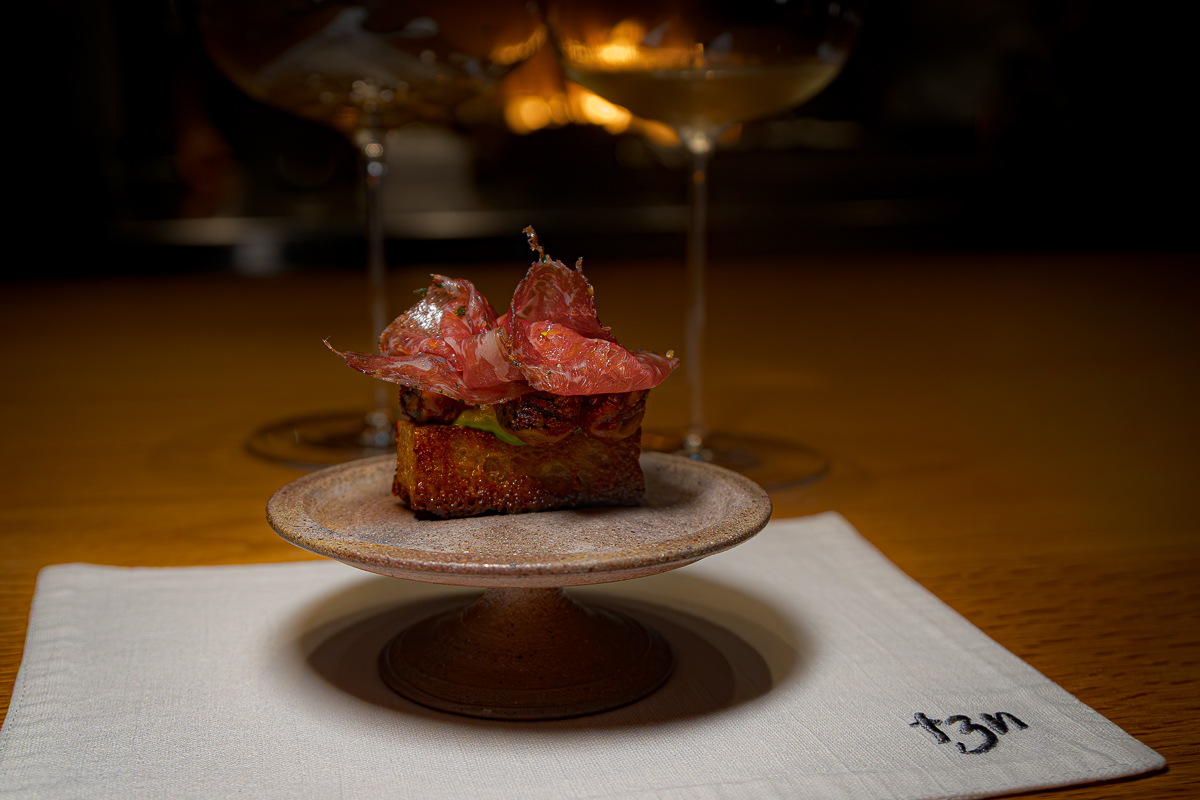
The Not-So-French Toast
Where others would send out a palate cleanser, here comes a “French toast.” Sourdough spelt bread, chive emulsion, grilled mussels, sumac, Japanese mustard, and cured Australian Angus sirloin aged thirty days, dressed with ponzu and lime zest – assembled in front of us under the half-smile of scrutiny and desire.
It’s an absurd list of ingredients, yet they fuse without confusion.
There is sea, there is fat, there is the crunch of the toast, there is the acidity that keeps the dish from becoming heavy, and of course, there is that meat which, on its own, would be worth a good moment beside a good wine.
Not the truffle-laden version that made headlines, but competent – too competent, perhaps.
The problem of creating expectations over time.
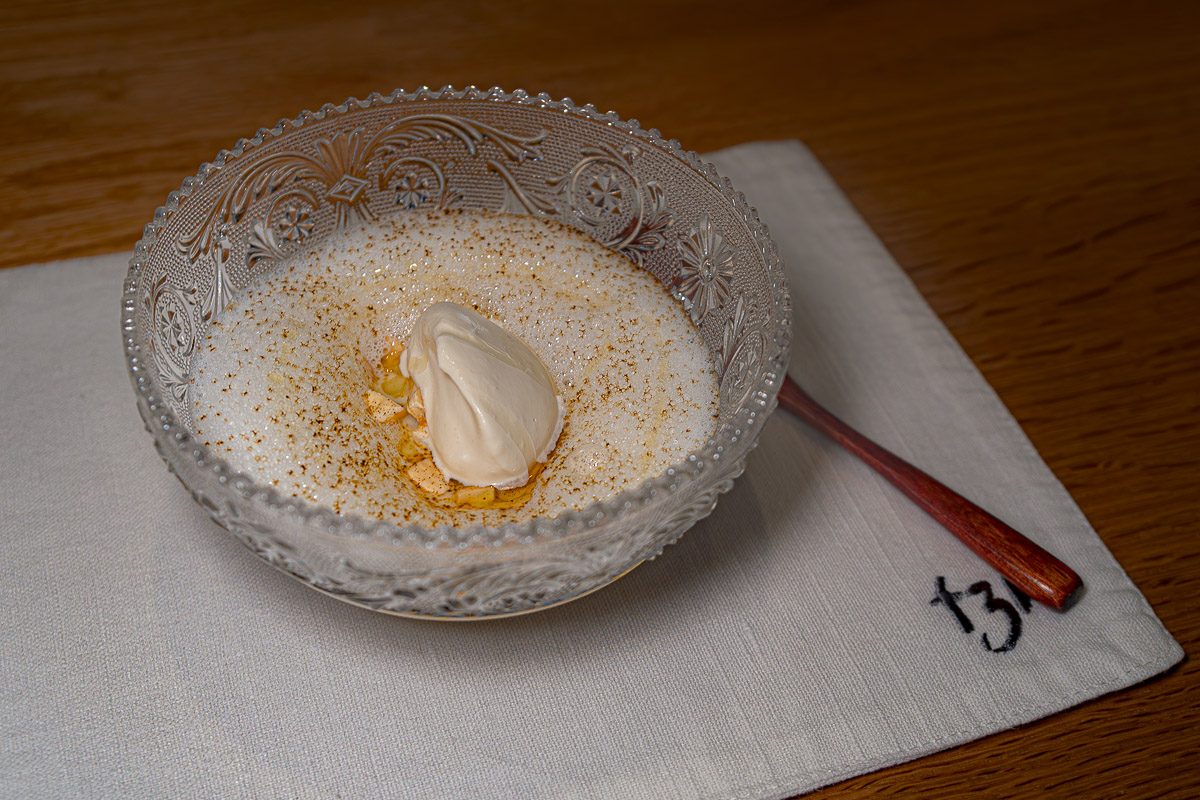
The Onion Soup
Another Frantzén signature, found in all his houses: onion, almond, and liquorice.
A velouté of puréed onion, with chopped toasted almonds, milk foam, liquorice cream, and almond oil.
The caramelised onions and almonds dominate – a flirtation of sweetness and texture.
The liquorice? Mercifully faint, confined to a cream and dusting.
É um prato salgado que me deixaria feliz como sobremesa, e por isso harmoniza tão bem com o Madeira Barbeito 5 anos que o acompanhou. Um Madeira jovem, com acidez vibrante e notas de caramelo que ecoam as cebolas. Funcionou – embora um Madeira mais velho, com mais complexidade, tivesse elevado ainda mais o momento.
It’s a savoury dish that could easily pass for dessert – hence the pairing with Madeira Barbeito 5 Years. Young, bright, caramel-toned, its acidity echoing the onions perfectly.
It works. Though an older Madeira, with more oxidation and gravitas, might have lifted it further.
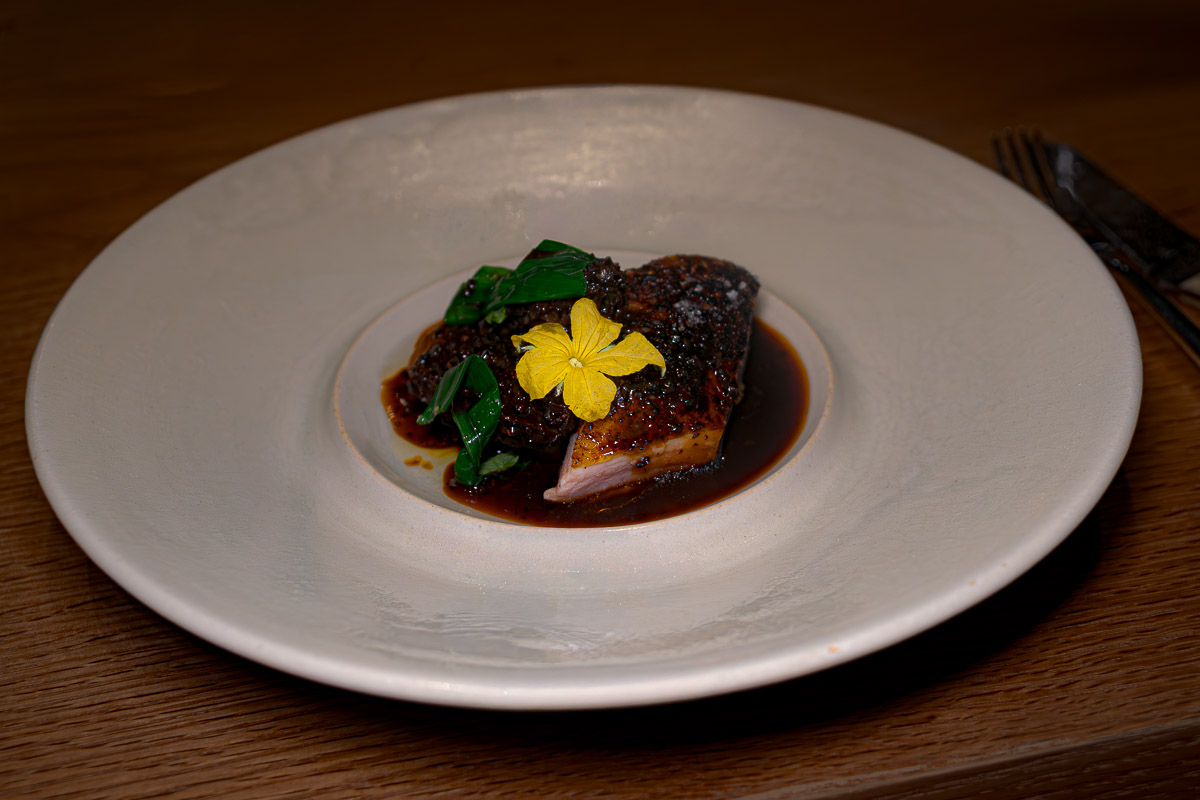
Guinea Fowl
Why don’t we see more guinea fowl on fine-dining menus?
While the world of fine dining keeps serving pigeon and duck, here the bird is different – grilled whole, then plated: the breast, white asparagus, wild garlic, and morels stuffed with the bird’s own farce.
Finished with a truffle périgourdine sauce, mint, and cucumber flowers.
The breast is firm, moist yet almost rustic—probably on purpose. The sauce brings acidity and umami once again. The morels are irresistible: tangy on the outside, filled with a savoury mousse within. At this stage, the acidity is welcome; the dish needs it to stay light.
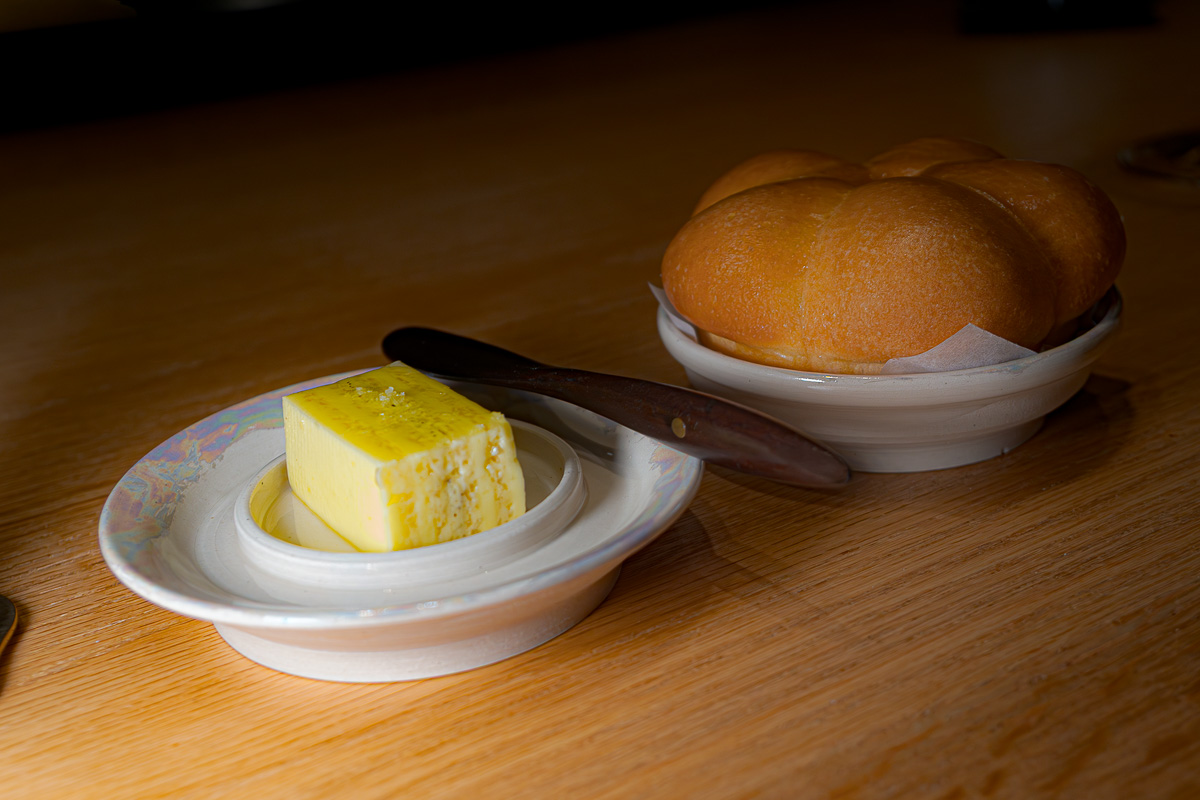
To accompany the final savoury course, Frantzén’s famous Parker House roll – the bread half the world insists on copying. These are the little American rolls of the 1870s, first created at the Parker House Hotel in Boston, which Frantzén has reimagined with layered butter: salted French butter, truffle butter, and shallot-confit butter.
Served hot and airy, gone in seconds.
Alongside, the famous Parker House roll – that buttery, pillowy bread Frantzén has turned into a cult.
Born in Boston in the 1870s, reimagined here with laminated butters: salted French, truffle, and shallot confit.
Served hot and airy, gone in seconds.
O tinto é um Bass Phillip “Estate” 2019, Pinot Noir australiano – elegante, mas com taninos firmes e uma persistência que corta a gordura da ave sem matar o prazer. Complexo e mais estruturado que o habitual, fruto do ano – ano esse que coincidiu com a última colheita assinada pelo fundador Phillip Jones. E que despedida magnífica criou.
The red was a Bass Phillip ‘Estate’ 2019, an Australian Pinot Noir — elegant, yet with firm tannins. Complex and more structured than usual, a product of its vintage — a year that happened to coincide with the final harvest signed by founder Phillip Jones. And what a magnificent farewell it was.
Its poise cuts the bird’s richness without killing the pleasure.
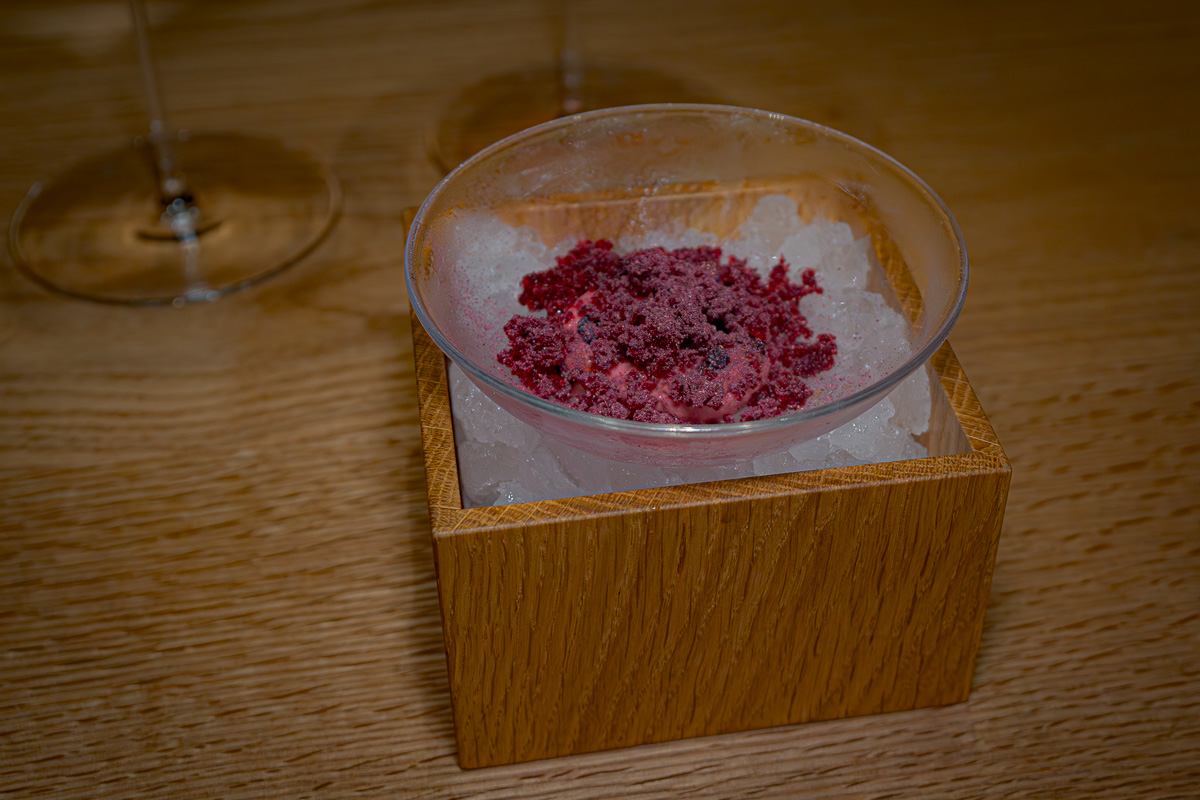
The Farewell
First, a half-frozen lingonberry marshmallow with spruce oil, blackcurrants, aged balsamic vinegar, and rose powder. Intense red fruit flavour – cold, crisp, bright. Impossible not to like.
Then, love is disguised as warm matcha waffles topped with roasted pistachios and vanilla oil.
Served with a mélange of white cloudberry jam, matcha, pistachio brittle, caramelised Earl Grey mousse, milky oolong oil, and carrot ice cream.
A festival of teas and infusions, yet what stands out is the pistachios’ crunch and the vanilla’s perfume.
The sauces and ice cream melt together into a creamy pool, and eating it with your hands – dipping a waffle into the mess – takes you straight back to childhood.
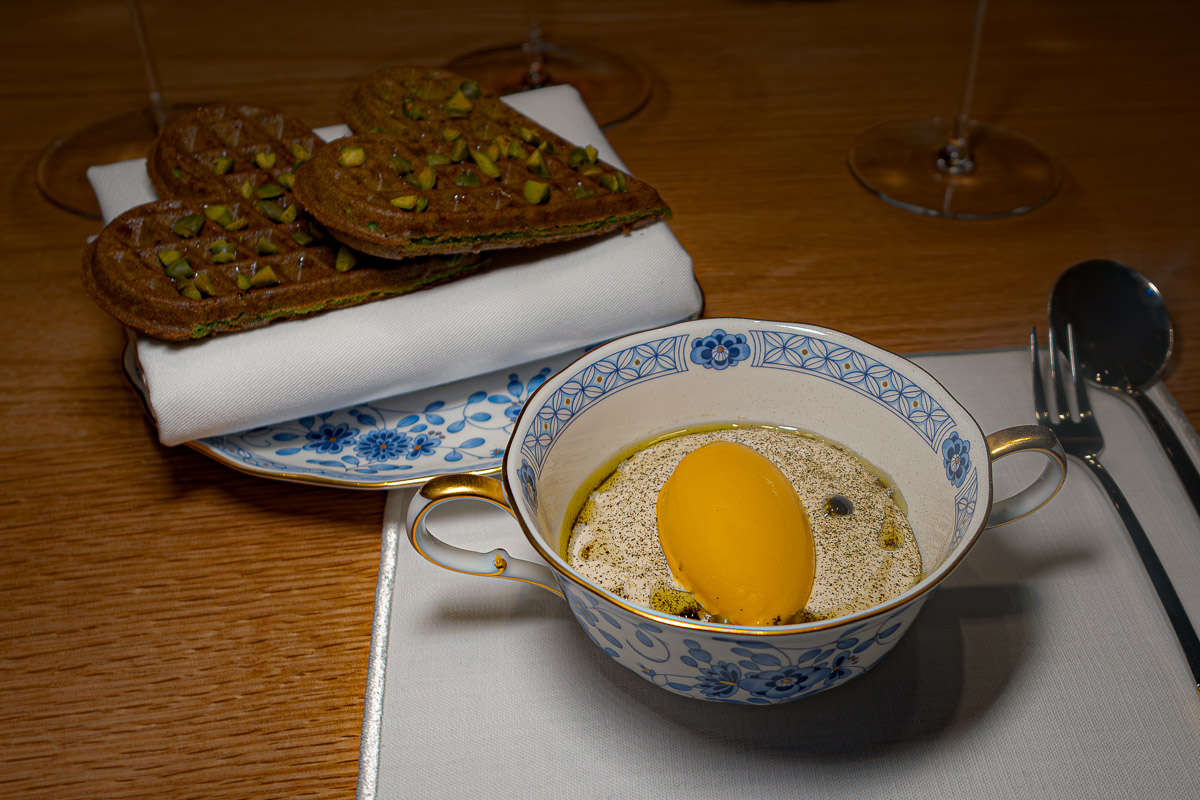
To close, a Domaine Huet Vouvray “Le Mont” Moelleux 2022 – a late-harvest Chenin Blanc where mineral tension meets the sweetness of fruit and honey.
Its acidity keeps everything alive.
The Final Path
We return to the lounge. Tea, coffee, or something stronger – there are options for all tastes.
First, a plate of fruit: Japanese melon and Miyazaki mango with a touch of yuzu.
The melon is flawless. The mango – perhaps the best I’ve ever tasted. Sweet, creamy, almost indecent in its perfection.
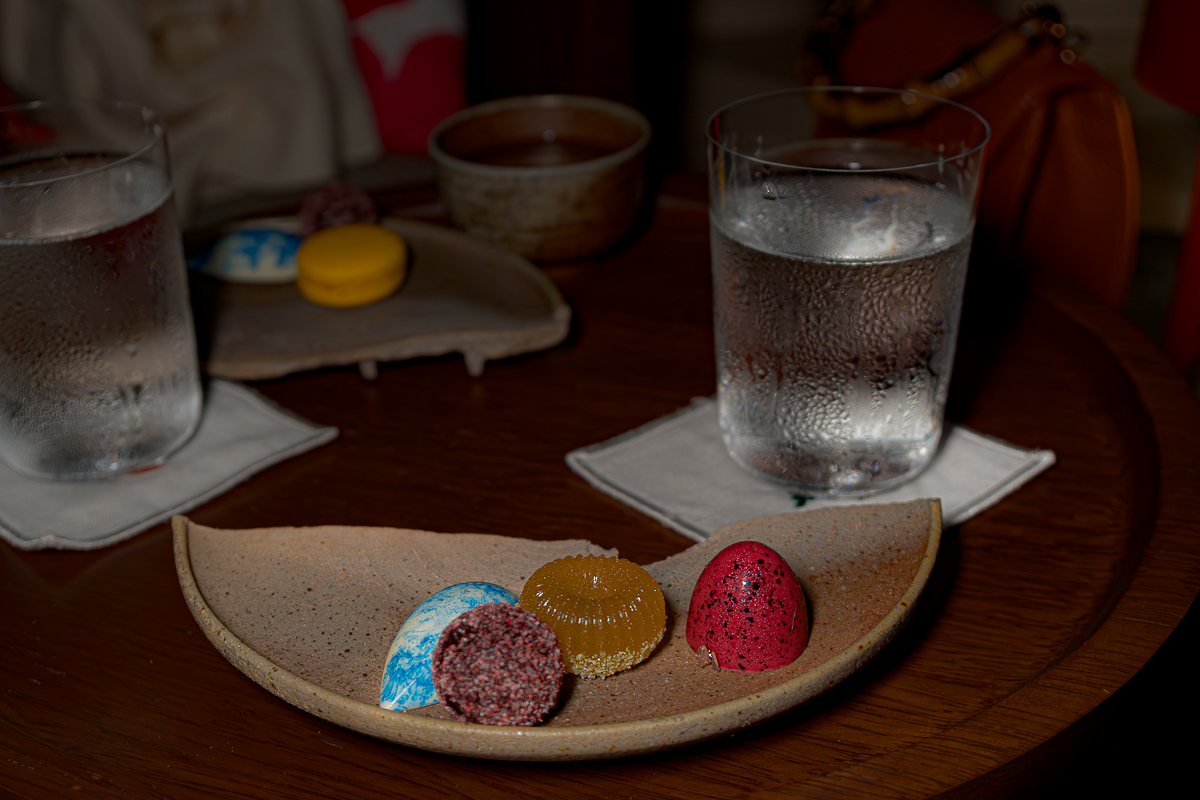
When it seems to be over, a flurry of petit fours appears, and tiny cardamom madeleines – light, aromatic, vanishing on contact.
The madeleines lingered in memory. I should have asked for a box to take home.
The System
Now, with time and distance, I can say it plainly: FZN isn’t a restaurant. It’s a system.
Everything works. Everything is timed to the second.
The service is exceptional, even by three-star standards – no intrusion, no pretence.
There’s integration, active listening, and technical precision.
Everything seems effortless, which only means it was painstakingly engineered.
Frantzén built an empire on precision, and Torsten Vildgaard runs this outpost with the serenity of someone who has mastered his craft.
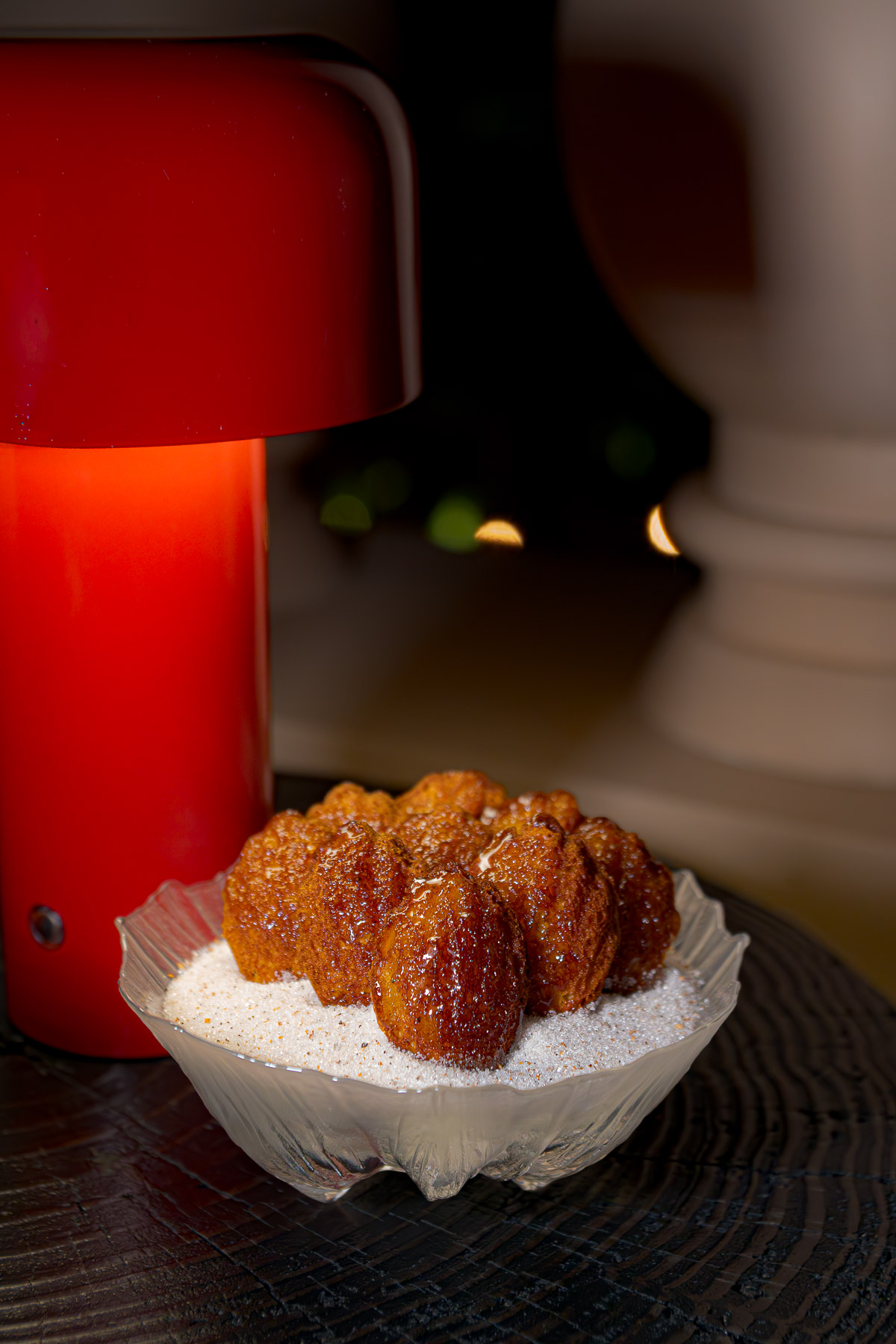
The entire team — both dining room and kitchen — was recruited from all over the world, including Portugal, with many coming from Björn Frantzén’s other restaurants. It is a global operation, almost military in its precision.
Frantzén has built an empire upon precision, and Torsten Vildgaard leads this outpost with the serenity of someone who has mastered the craft.
A flaw here and there brings us back to Earth, and that too has value.
Almost a year since opening, and with its stars already in place, Vildgaard is finally free to imprint his own signature on this already memorable project.
And then comes the question:
Does a replica-restaurant deserve the same stars as the original?
Some say no.
That Dubai merely imports a packaged genius.
That Vildgaard is merely performing a score long written and already replicated.
That this is nothing more than a luxury franchise.
I disagree. Completely.
A week before the Michelin announcement, there were no doubts left.
Not because it copies the original, but because it works in its own context.
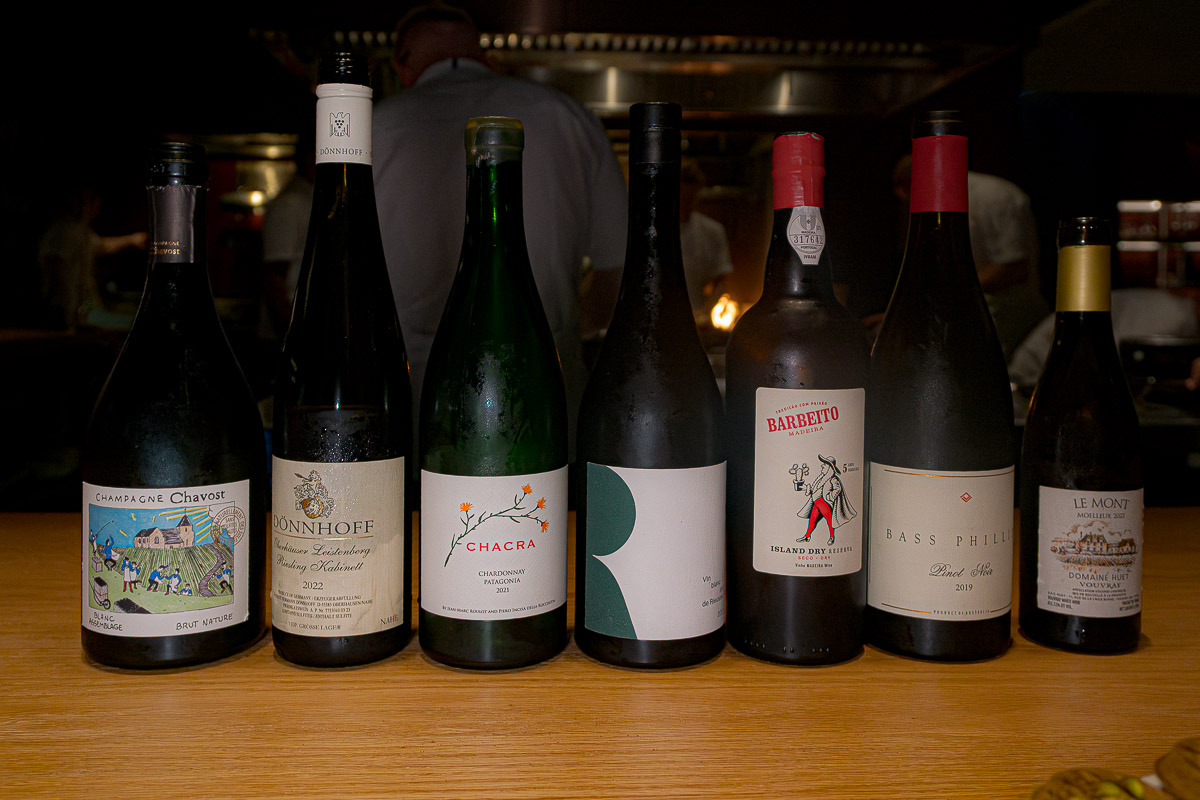 And that’s what most forget: Vildgaard and his team are not mere executors. They are interpreters of exceptional calibre. The paradox of an “original replica.”
And that’s what most forget: Vildgaard and his team are not mere executors. They are interpreters of exceptional calibre. The paradox of an “original replica.”
If it were that easy, there would be more Björn Frantzéns in the world.
The FZN we visited will not be the FZN to come.
And that isn’t a weakness – it’s a promise.
Final Toughts
Some chefs build dishes, and others build worlds.
Frantzén belongs to the latter.
FZN is a microcosm of rigour, time, and obsessive attention to detail.
Frantzén has built a system of his own and managed to transpose it onto Dubai’s gilded, dizzying rhythm. The house runs with the serenity of those who understand true luxury: the absence of haste, the measured cadence of voices, the discreet gleam that appears only where it should.
But not everything is reverence.
Here and there, some of the more subtle courses lacked the force of the opening snacks.
Control is absolute – almost excessive, almost Japanese in its restraint.
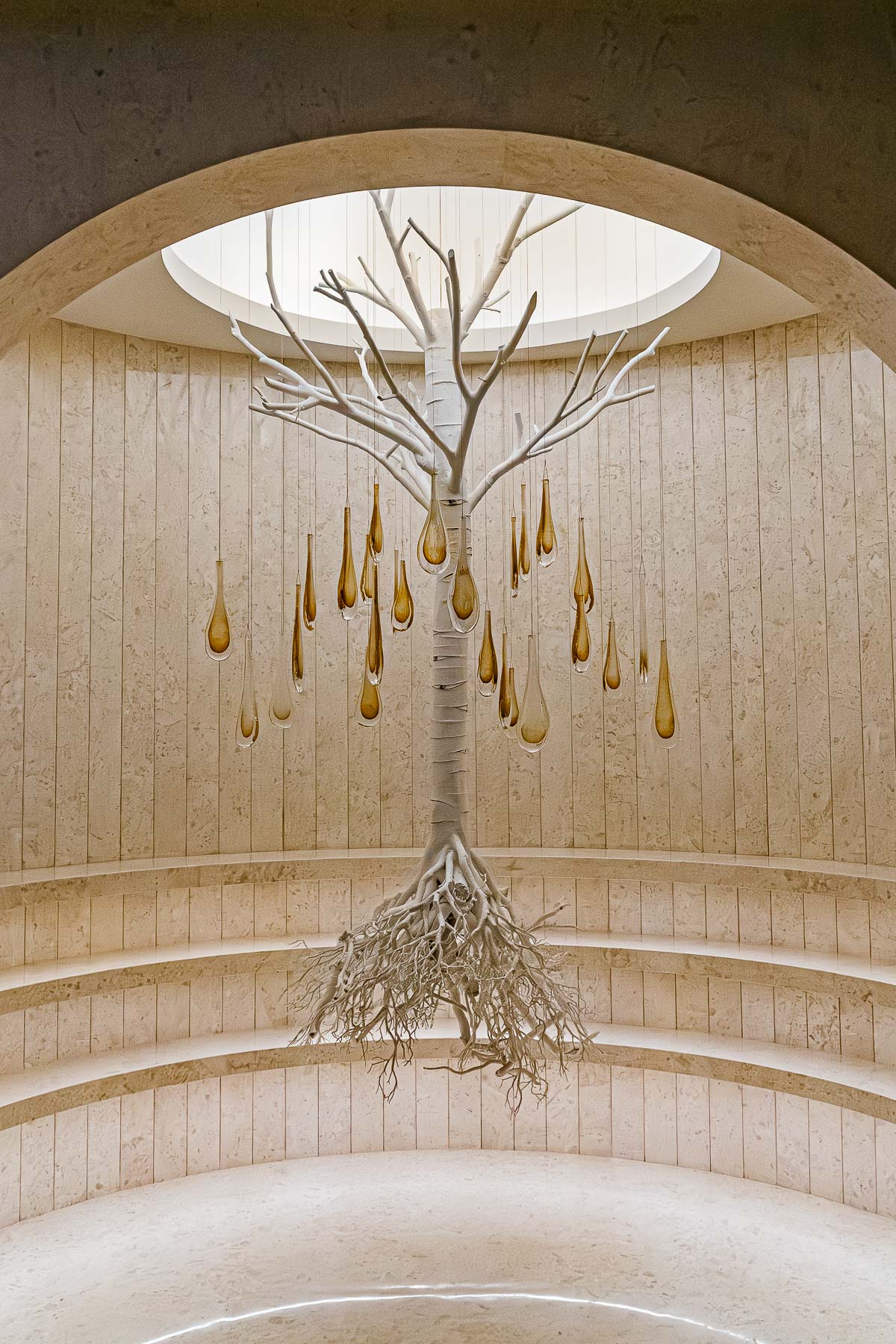 The question was never whether a replica deserves the same stars as its original.
The question was never whether a replica deserves the same stars as its original.
The question is whether it can create its own universe, its own reason to exist.
And the answer here is clear: this is not a copy. It is a free translation – one in which we wonder whether three stars are enough for what Vildgaard may yet build here – not merely another chapter in Frantzén’s success, but his own new beginning.
Dubai didn’t need another signature restaurant.
It needed an alternative.
And FZN delivers precisely that: a place where luxury is intelligent, where precision doesn’t stifle pleasure, where everything works because someone cared about the smallest detail.
Yes, it’s expensive – around 2,000 AED for the tasting menu, plus between 1,400 and 5,000 AED for the wine pairings, depending on the level chosen. It’s the cost of importing the best of the entire world into the heat of the Arabian desert.
But it’s also the price of an experience that endures – not in your pockets, but somewhere where the things that matter tend to live.
Address — Atlantis The Royal, Crescent Road, Palm Jumeirah, Dubai
Reservations — +971 54 584 3105
Opening hours — Tuesday to Sunday, 5:00 pm – 1:00 am | Saturday and Sunday, 12:30 pm – 4:00 pm
Prices — From €450 (excluding wines)
Unmissable — The snacks, the service, the produce, the langoustine, the guinea fowl, the waffles, and the mango.
Executive Chef — Torsten Vildgaard
Chef Patron — Björn Frantzén
General Manager — Karin Ågren
Sommelier — Kyle Barton
Distinctions — Three Michelin Stars (Michelin Guide Dubai 2025), 4 Toques and Restaurant of the Year 2025 by Gault Millau Dubai, 4 Stars on Star Wine List

